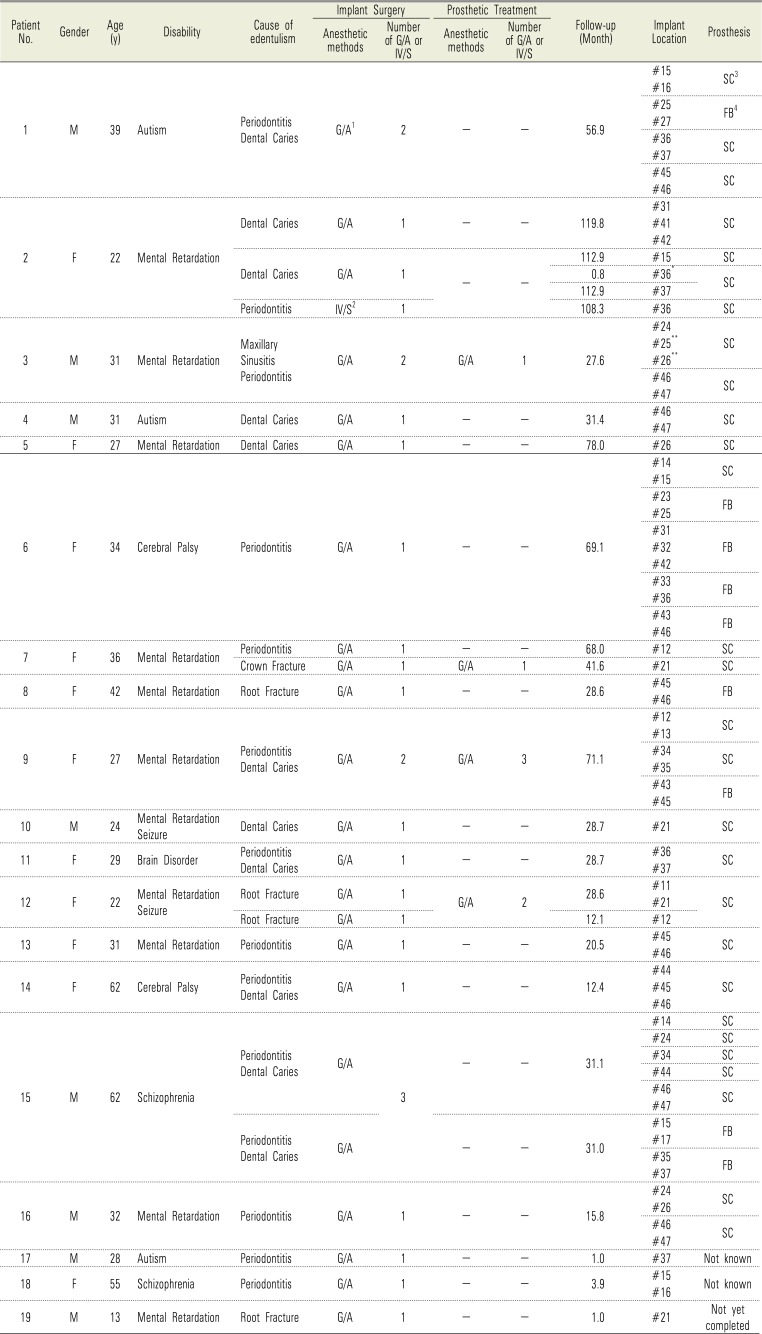1. Gabre P, Martinsson T, Gahnberg L. Longitudinal study of dental caries, tooth mortality and interproximal bone loss in adults with intellectual disability. Eur J Oral Sci. 2001; 109:20–26. PMID:
11330930.

2. Anders PL, Davis EL. Oral health of patients with intellectual disabilities: A systematic review. Spec Care Dentist. 2010; 30:110–117. PMID:
20500706.

3. Cheng RH, Leung WK, Corbet EF, King NM. Oral health status of adults with down syndrome in hong kong. Spec Care Dentist. 2007; 27:134–138. PMID:
17972443.

4. Cumella S, Ransford N, Lyons J, Burnham H. Needs for oral care among people with intellectual disability not in contact with community dental services. J Intellect Disabil Res. 2000; 44:45–52. PMID:
10711649.

5. Tiller S, Wilson KI, Gallagher JE. Oral health status and dental service use of adults with learning disabilities living in residential institutions and in the community. Community Dent Health. 2001; 18:167–171. PMID:
11580093.
6. Moon SY, Kim SG. Implants in psychiatric patients. J Korean Assoc Disabil Oral Health. 2007; 3:1–5.
7. Albrektsson T, Isidor F. Consensus report of session iv. In : Lang NP, Karring T, editors. Proceedings of the 1st european workshop on periodontology. London: Quintessence;1994. p. 165–169.
8. Albrektsson T, Sennerby L. State of the art in oral implants. J Clin Periodontol. 1991; 18:474–481. PMID:
1890231.

9. Seo KS, Jang KT, Kim HJ, Yum KW. The status of comprehensive dental treatment and type of disabilities of the patients treated under outpatient general anesthesia at the clinic for the disabled in seoul national university dental hospital. J Korean Dent Soc Anesthesiol. 2006; 6:82.

10. Kim CS. Research on oral status of hearing impaired youth by using qlf-d. J Korea Contents Assoc. 2013; 13:305–311.

11. Romero-Perez MJ, Mang-de la Rosa Mdel R, Lopez-Jimenez J, Fernandez-Feijoo J, Cutando-Soriano A. Implants in disabled patients: A review and update. Med Oral Patol Oral Cir Bucal. 2014; 19:e478–e482. PMID:
24608221.

12. Binkley CJ, Johnson KW, Abadi M, Thompson K, Shamblen SR, Young L, et al. Improving the oral health of residents with intellectual and developmental disabilities: An oral health strategy and pilot study. Eval Program Plann. 2014; 47:54–63. PMID:
25137553.

13. Rogers JO. Implant-stabilized complete mandibular denture for a patient with cerebral palsy. Dent Update. 1995; 22:23–26. PMID:
7664968.
14. Heckmann SM, Heckmann JG, Weber HP. Clinical outcomes of three parkinson's disease patients treated with mandibular implant overdentures. Clin Oral Implants Res. 2000; 11:566–571. PMID:
11168250.

15. Lustig JP, Yanko R, Zilberman U. Use of dental implants in patients with down syndrome: A case report. Spec Care Dentist. 2002; 22:201–204. PMID:
12580359.

16. Lopez-Jimenez J, Romero-Dominguez A, Gimenez-Prats MJ. Implants in handicapped patients. Med Oral. 2003; 8:288–293. PMID:
12937390.
17. Smith RA, Berger R, Dodson TB. Risk factors associated with dental implants in healthy and medically compromised patients. Int J Oral Maxillofac Implants. 1992; 7:367–372. PMID:
1289263.
18. Anner R, Grossmann Y, Anner Y, Levin L. Smoking, diabetes mellitus, periodontitis, and supportive periodontal treatment as factors associated with dental implant survival: A long-term retrospective evaluation of patients followed for up to 10 years. Implant Dent. 2010; 19:57–64. PMID:
20147817.

19. Engfors I, Ortorp A, Jemt T. Fixed implant-supported prostheses in elderly patients: A 5-year retrospective study of 133 edentulous patients older than 79 years. Clin Implant Dent Relat Res. 2004; 6:190–198. PMID:
15841579.

20. Grant BT, Kraut RA. Dental implants in geriatric patients: A retrospective study of 47 cases. Implant Dent. 2007; 16:362–368. PMID:
18091164.

21. Diz P, Scully C, Sanz M. Dental implants in the medically compromised patient. J Dent. 2013; 41:195–206. PMID:
23313715.

22. Branemark PI, Hansson BO, Adell R, Breine U, Lindstrom J, Hallen O, et al. Osseointegrated implants in the treatment of the edentulous jaw. Experience from a 10-year period. Scand J Plast Reconstr Surg Suppl. 1977; 16:1–132. PMID:
356184.
23. Friberg B, Henningsson C, Jemt T. Rehabilitation of edentulous mandibles by means of turned branemark system implants after one-stage surgery: A 1-year retrospective study of 152 patients. Clin Implant Dent Relat Res. 2005; 7:1–9. PMID:
15903168.
24. Carr AB, Choi YG, Eckert SE, Desjardins RP. Retrospective cohort study of the clinical performance of 1-stage dental implants. Int J Oral Maxillofac Implants. 2003; 18:399–405. PMID:
12814315.
25. Rosenquist B, Grenthe B. Immediate placement of implants into extraction sockets: Implant survival. Int J Oral Maxillofac Implants. 1996; 11:205–209. PMID:
8666452.

26. Evian CI, Emling R, Rosenberg ES, Waasdorp JA, Halpern W, Shah S, et al. Retrospective analysis of implant survival and the influence of periodontal disease and immediate placement on long-term results. Int J Oral Maxillofac Implants. 2004; 19:393–398. PMID:
15214224.
27. Nam H, Sung KW, Kim MG, Lee K, Kwon D, Chi SI, et al. Immediate implant placement for schizophrenic patient with outpatient general anesthesia. J Dent Anesth Pain Med. 2015; 15:147–151. PMID:
28879272.

28. Isaksson R, Becktor JP, Brown A, Laurizohn C, Isaksson S. Oral health and oral implant status in edentulous patients with implant-supported dental prostheses who are receiving long-term nursing care. Gerodontology. 2009; 26:245–249. PMID:
19555359.

29. Kim JW, Kim YK. Clinical study about the implant treatment in the patients with systemic disease. Implantology. 2009; 13:64–75.
30. Seo KS, Lee JH, Shin TJ, Yi YE, Kim HJ, Yum KW, et al. Intravenous sedation of cerebral palsy patient for dental implant ct taking-a case report. J Korean Assoc Disabil Oral Health. 2008; 4:21–25.
31. Hong YJ, Dan JB, Kim MJ, Kim HJ, Seo KS. Prognosis after treatment with multiple dental implants under general anesthesia and sedation in a cerebral palsy patient with mental retardation: A case report. J Dent Anesth Pain Med. 2017; 17:149–155. PMID:
28879344.

32. Ekfeldt A. Early experience of implant-supported prostheses in patients with neurologic disabilities. Int J Prosthodont. 2005; 18:132–138. PMID:
15889661.
33. Romeo E, Lops D, Margutti E, Ghisolfi M, Chiapasco M, Vogel G. Long-term survival and success of oral implants in the treatment of full and partial arches: A 7-year prospective study with the iti dental implant system. Int J Oral Maxillofac Implants. 2004; 19:247–259. PMID:
15101597.



